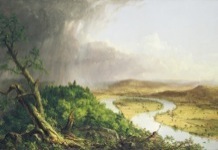
The Oxbow
Thomas Cole
ArtScapades presents Art that Defines America which covers art from the founding of America to the early decades of the 20th Century. Lectures below can be used in a series, individually, or customized to fit your needs.
Colonial Portraiture: From Battlefield to Living Room
Early American Portraiture: From Folk Art to Fine Art
American Conflicts: From the Revolution to the Civil War
Artists Abroad: From American to Expatriate
American Vistas: From the Hudson River to Uncharted Territories
American Images: From Camera to Canvas
The Ashcan School: From Beautiful to Gritty
American Regionalism: From the Heartland to All of America
Elements of Art:
Each ArtScapades lecture begins with a brief overview of the seven elements of art that artists use when composing a piece of art – Color, Line, Texture, Value, Shape, Form, and Space. Each element is illustrated using a representative work of art.
Timeline of Art:
In each lecture, ArtScapades places the artists in context with an abbreviated timeline of art history.
In Colonial Portraiture, ArtScapades gives the background of the development of portraiture in America, including information on artists in the military, the rise of the middle class and the importance of art to document history.
In Early American Portraiture, ArtScapades will focus on the overall development of portraiture in early America. This lecture looks at major fine portrait artists of the time and includes Early American Folk Artists who played an important but sometimes unsung role in early American art.
In American Conflicts, ArtScapades discusses the importance of art during the Revolutionary and Civil Wars. The focus will be on the major artists who commemorated the conflicts, working either on the battlefield or back in their studios.
In Artists Abroad, ArtScapades looks at American artists who, despite their expatriate status, are among America’s greatest talents.
In American Vistas and American Images, ArtScapades focuses on the Hudson River School painters, and explains the changes in art brought about by national pride, the westward expansion, and the growth of travel.
In The Ashcan School, ArtScapades explores how a modern art movement developed in America led by artists of The Ashcan School and The Eight.
In American Regionalism, ArtScapades details how artists from the midwest included realism in their works, how FDR’s New Deal affected the art world, and how the movement which had its’ roots in the heartland, affected the entire country.
Artists:
Approximately fifteen works per artist are discussed including iconic works plus those that illustrate significant trends and events in their lives and careers.
In Colonial Portraiture, ArtScapades chronicles the life of four artists and their works, John Singleton Copley, Charles Willson Peale, Gilbert Stuart, and John Trumbull.
In Early American Portraiture, ArtScapades details the lives and works of three fine artists, John Singleton Copley, Gilbert Stuart, and Thomas Sully and three folk artists, Joshua Johnston, Ammi Phillips, and Erastus Salisbury Field.
In American Conflicts, ArtScapades discusses the lives and works of Charles Willson Peale, John Trumbull, Sanford Robinson Gifford, Winslow Homer, and Conrad Wise Chapman.
In Artists Abroad, ArtScapades focuses on the works of Mary Cassatt, John Singer Sargent, and James McNeill Whistler.
In American Vistas, ArtScapades presents three Hudson River School artists, Thomas Cole, Frederic Edwin Church and Asher B. Durand.
In American Images, ArtScapades looks at the art of Albert Bierstadt, Thomas Eakins, and Winslow Homer.
In The Ashcan School, ArtScapades explores George Bellows, Robert Henri, William Glackens, John Sloan, and Edward Hopper.
In American Regionalism, ArtScapades presents artists that include Thomas Hart Benton, Grant Wood, John Steuart Curry, and Andrew Wyeth.
Equipment:
ArtScapades lectures are presented from our laptop, using your venue’s projection system.
